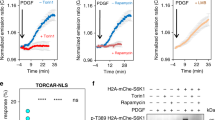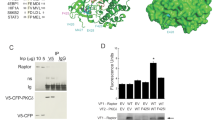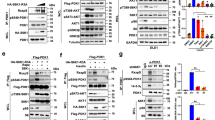Abstract
The protein kinase p70 S6K1 is regulated in response to cytokines, nutrients and growth factors, and plays an important role in the development of a variety of human diseases. Mammalian target of rapamycin (mTOR) is known to phosphorylate and thereby activate p70 S6K1. p70 S6K1 phosphorylates different cytoplasmic and nuclear substrates involved in the regulation of protein synthesis, cell cycle, cell growth and survival. Recently, we have shown that mTOR-mediated phosphorylation of p70 S6K1 at T389 also regulates its nucleocytoplasmic localization. Since this phosphorylation is associated with its kinase activity the question whether p70 S6K1 phosphorylation or kinase activity is essential for its proper localization remained elusive. Recently, the chemical compound PF-4708671 has been demonstrated to block p70 S6K1 kinase activity while inducing its phosphorylation at T389. This potential of PF-4708671 to separate p70 S6K1 activity from its T389 phosphorylation allowed us to demonstrate that the proper nucleocytoplasmic localization of this kinase depends on its mTOR-mediated phosphorylation but not on its kinase activity. These findings provide important insights into the regulation of p70 S6K1 and allow a more detailed understanding of subcellular enzyme localization processes.



Similar content being viewed by others
References
Fenton TR, Gout IT (2011) Functions and regulation of the 70 kDa ribosomal S6 kinases. Int J Biochem Cell Biol 43:47–59
Holz MK, Blenis J (2005) Identification of S6 kinase 1 as a novel mammalian target of rapamycin (mTOR)-phosphorylating kinase. J Biol Chem 280:26089–26093
Holz MK, Ballif BA, Gygi SP, Blenis J (2005) mTOR and S6K1 mediate assembly of the translation preinitiation complex through dynamic protein interchange and ordered phosphorylation events. Cell 123:569–580
Julien LA, Carriere A, Moreau J, Roux PP (2010) mTORC1-activated S6K1 phosphorylates Rictor on threonine 1135 and regulates mTORC2 signaling. Mol Cell Biol 30:908–921
Karni R, Stanchina E, Lowe SW, Sinha R, Mu D, Krainer AR (2007) The gene encoding the splicing factor SF2/ASF is a proto-oncogene. Nat Struct Mol Biol 14:185–193
Meyuhas O, Dreazen A (2010) Ribosomal protein S6 kinase: from TOP mRNAs to cell size. Progr Mol Biol Translat Sci 90:109–153
Pearce LR, Alton GR, Richter DT, Kath JC, Lingardo L, Chapman J, Hwang C, Alessi DR (2010) Characterization of PF-4708671, a novel and highly specific inhibitor of p70 ribosomal S6 kinase (S6K1). Biochem J 431:245–255
Rosner M, Hengstschläger M (2010) Evidence for cell cycle-dependent, rapamycin-resistant phosphorylation of ribosomal protein S6 at S240/244. Amino Acids 39:1487–1492
Rosner M, Hengstschläger M (2011) Nucleocytoplasmic localization of p70 S6K1, but not of its isoforms p85 and p31, is regulated by TSC2/mTOR. Oncogene doi: 10.1038/onc.2011.165
Rosner M, Siegel N, Fuchs C, Slabina N, Dolznig H, Hengstschläger M (2010) Efficient. siRNA-mediated prolonged gene silencing in human amniotic fluid stem cells. Nat Protoc 5:1081–1095
Rosner M, Fuchs C, Dolznig H, Hengstschläger M (2011) Different cytoplasmic/nuclear distribution of S6 protein phosphorylated at S240/244 and S235/236. Amino Acids 40:595–600
Ruvinsky I, Meyuhas O (2006) Ribosomal protein S6 phosphorylation: from protein synthesis to cell size. Trends Biochem Sci 31:342–348
Sengupta S, Peterson TR, Sabatini DM (2010) Regulation of the mTOR complex 1 pathway by nutrients, growth factors, and stress. Mol Cell 40:310–322
Shaw RJ (2008) mTOR signaling: RAG GTPases transmit the amino acid signal. Trends Biochem Sci 33:565–568
Wang X, Proud CG (2009) Nutrient control of TORC1, a cell-cycle regulator. Trends Cell Biol 19:260–267
Yang Q, Guan K-L (2007) Expanding mTOR signaling. Cell Res 17:666–681
Yuan R, Kay A, Berg W, Lebwohl D (2009) Targeting tumorigenesis: development and use of mTOR inhibitors in cancer therapy. J Hematol Oncol 2:45
Acknowledgments
Research in our laboratory is supported via the Österreichische Nationalbank.
Author information
Authors and Affiliations
Corresponding author
Rights and permissions
About this article
Cite this article
Rosner, M., Schipany, K. & Hengstschläger, M. p70 S6K1 nuclear localization depends on its mTOR-mediated phosphorylation at T389, but not on its kinase activity towards S6. Amino Acids 42, 2251–2256 (2012). https://doi.org/10.1007/s00726-011-0965-4
Received:
Accepted:
Published:
Issue Date:
DOI: https://doi.org/10.1007/s00726-011-0965-4




